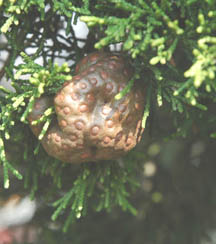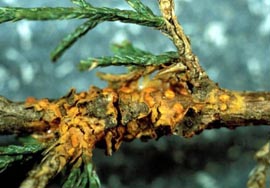Three Gymnosporangium Rusts | |
|---|---|
| April 11, 2007 | |
|
Most of our readers are well aware of three Gymnosporangium rusts on trees. These are cedar-apple, cedar-hawthorn, and cedar-quince rusts. Two hosts are needed for the diseases to be maintained in the landscape. In all three cases, the evergreen host is eastern red cedar and the deciduous host is a plant in the Rosaceae family. Although cedar-apple rust is of greatest concern in apple orchards, it is not nearly as problematic in crabapple plantings. Resistance available in most of the new crabapple cultivars and fungicides used to control scab also controls cedar-apple rust on this host. The current disease (and associated host) of concern in the landscape is cedar-quince rust on hawthorn. Some ask why this disease is not called cedar-hawthorn rust, but that name is associated with a different Gymnosporangium rust that causes only leaf spots. Cedar-quince rust is the most damaging to hawthorn because it affects fruit, stems, and petioles. The galls that form on hawthorn stems give the stem a roughened, swollen appearance that is much more obvious when the orange masses of spores are visible. The pathogen kills fruit and girdles twigs, causing tip blight on hawthorn. You can see last year's damage now because blight twig tips do not develop leaves. The twig tips fall off, or you can help improve tree appearance by pruning them out. Galls of the Gymnosporangium rusts can be found on red cedar now. They are hard and pitted, as shown with the cedar-apple rust gall image below.  Internal tissue is solid. Insect galls may appear similar but contain chambers, exit holes, or insects. As spring temperatures increase and moisture fluctuates, the red cedar galls form orange, gelatinous spore masses, as seen on the cedar-quince rust galls below.  These spores blow to susceptible hawthorns, where stem galls are initiated. Resistant varieties are the easiest disease control for these rusts, but unfortunately there is no resistance in hawthorns to cedar-quince rust. In addition, the thornless cockspur hawthorn and Washington hawthorn are both very susceptible to this disease. So how can we control cedar-quince rust on hawthorn? Look for swollen stem galls on red cedars in the area. Either remove this source of infection (spores blow from the red cedars to the hawthorn) or spray the hawthorns to protect them from spores that will soon be moving from the red cedars. Spray options are listed in the Illinois commercial and homeowner pest management handbooks, available online at http://pubsplus.uiuc.edu/. Sprays are protective and must be initiated as hawthorn flower buds begin to open. For complete protection, the sprays must continue according to label recommendations until 1 to 2 weeks past petal fall. Look at the chemical options at the end of each chapter to see which ones have systemic mobility. The systemic products have some kickback activity if you are bit late in getting the sprays out; and they are less likely to be affected by weather conditions. Product cost is higher for the systemic chemicals, compared to protective-contact costs, but you have fewer sprays and more reliable disease control. For more information, refer to Report on Plant Disease, no. 802, “Rust Diseases of Apple, Crabapple, and Hawthorn,” available on the Web at http://www.ag.uiuc.edu/%7Evista/horticul.htm. | |
| Author: | Nancy Pataky |
